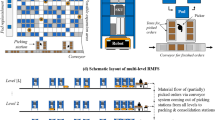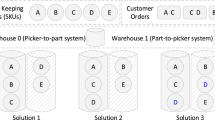Abstract
The robotic mobile fulfillment system, where mobile robots carry racks to stationary stations for human pickers, is widely used in e-commerce warehouses. The operational efficiency of the system is largely affected by the organization of the order picking process. In this paper, we investigate an order picking tactic in a robotic mobile fulfillment system that allows racks moving between multiple picking stations in order to feed more orders during one visit and therefore save the overall throughput time. To evaluate this operational tactic’s effectiveness, we propose a mathematical model to jointly optimize the order assignment, order sequencing, rack selection, and rack sequencing. A two-stage hybrid heuristic algorithm framework is then presented, including order assignment in the first stage and order and rack sequencing in the second stage. We conduct numerical experiments to validate the proposed algorithms’ performance under different strategies and find out that the inter-station operation can significantly save order throughput time on the testing cases. We also investigate the effects of several factors, including the number of picking stations, their capacities, the stock keeping unit diversity, and queue length. Furthermore, a solid simulation is carried out to show the rationale of using rack moves as the objective rather than the completion time.













Similar content being viewed by others
References
Azadeh K, De Koster R, Roy D (2019) Robotized and automated warehouse systems: review and recent developments. Transp Sci 53(4):917–945
Bartholdi III JJ, Hackman ST (2008) Warehouse and distribution science. Supply Chain and Logistics Institute, School of Industrial and Systems Engineering, Georgia Institute of Technology. https://www.scl.gatech.edu/sites/default/files/downloads/gtsclwarehouse_science_bartholdi.pdf
Boysen N, Briskorn D, Emde S (2017) Parts-to-picker based order processing in a rack-moving mobile robots environment. Eur J Opera Res 262(2):550–562
Boysen N, Briskorn D, Emde S (2017) Sequencing of picking orders in mobile rack warehouses. Eur J Opera Res 259(1):293–307
Boysen N, Fedtke S, Weidinger F (2018) Optimizing automated sorting in warehouses: the minimum order spread sequencing problem. Eur J Opera Res 270(1):386–400
Boysen N, de Koster R, Weidinger F (2019) Warehousing in the e-commerce era: a survey. Eur J Opera Res 277(2):396–411
Bozer YA, Aldarondo FJ (2018) A simulation-based comparison of two goods-to-person order picking systems in an online retail setting. Int J Prod Res 56(11):3838–3858
De Koster R, Le-Duc T, Roodbergen KJ (2007) Design and control of warehouse order picking: a literature review. Eur J Opera Res 182(2):481–501
Duan G, Zhang C, Gonzalez P, Qi M (2021) Performance evaluation for robotic mobile fulfillment systems with time-varying arrivals. Comp Ind Eng 158:107365
Füßler D, Boysen N (2019) High-performance order processing in picking workstations. EURO J Transp Logist 8(1):65–90
Grosse EH, Glock CH, Jaber MY, Neumann WP (2015) Incorporating human factors in order picking planning models: framework and research opportunities. Int J Prod Res 53(3):695–717
Gu J, Goetschalckx M, McGinnis LF (2007) Research on warehouse operation: a comprehensive review. Eur J Opera Res 177(1):1–21
Huang GQ, Chen MZ, Pan J (2015) Robotics in ecommerce logistics. HKIE. Transactions 22(2):68–77
Jaghbeer Y, Hanson R, Johansson MI (2020) Automated order picking systems and the links between design and performance: a systematic literature review. Int J Prod Res 58(15):4489–4505
Lamballais T, Roy D, De Koster MBM (2019) Inventory allocation in robotic mobile fulfillment systems. IISE Transactions pp 1–17
Li Z, Li W (2015) Mathematical model and algorithm for the task allocation problem of robots in the smart warehouse. Am J Opera Res 5(06):493
Li ZP, Zhang JL, Zhang HJ, Hua GW (2017) Optimal selection of movable shelves under cargo-to-person picking mode. Int J Simul Modell 16(1):145–156
Menéndez B, Pardo EG, Alonso-Ayuso A, Molina E, Duarte A (2016) Variable neighborhood search strategies for the order batching problem. Comp Opera Res 78:500–512
Merschformann M, Lamballais T, Koster MBMD, Suhl L (2019) Decision rules for robotic mobile fulfillment systems. Opera Res Perspect 6:100128
Mladenović N, Hansen P (1997) Variable neighborhood search. Comp Opera Res 24(11):1097–1100
Öncan T (2015) Milp formulations and an iterated local search algorithm with tabu thresholding for the order batching problem. Euro J Opera Res 243(1):142–155
QuickTron (2020) Quicktron. http://www.flashhold.com/english.php
Roy D, Nigam S, de Koster R, Adan I, Resing J (2019) Robot-storage zone assignment strategies in mobile fulfillment systems. Transp Res Part E: Logist Transp Rev 122:119–142
Scholz A, Schubert D, Wäscher G (2017) Order picking with multiple pickers and due dates-simultaneous solution of order batching, batch assignment and sequencing, and picker routing problems. Euro J Opera Res 263(2):461–478
Tanimoto TT (1957) Ibm internal report. Nov 17:1957
Valle CA, Beasley JE (2021) Order allocation, rack allocation and rack sequencing for pickers in a mobile rack environment. Computers & Operations Research 125:105090
Weidinger F, Boysen N, Briskorn D (2018) Storage assignment with rack-moving mobile robots in kiva warehouses. Transp Sci 52(6):1479–1495
Wurman PR, D’Andrea R, Mountz M (2008) Coordinating hundreds of cooperative, autonomous vehicles in warehouses. AI Magaz 29(1):9–9
Xi X, Liu C, Miao L (2018) Storage assignment and order batching problem in kiva mobile fulfilment system. Eng Optim 50(11):1941–1962
Yuan R, Graves SC, Cezik T (2019) Velocity-based storage assignment in semi-automated storage systems. Prod Opera Manag 28(2):354–373
Zhang J, Yang F, Weng X (2019) A building-block-based genetic algorithm for solving the robots allocation problem in a robotic mobile fulfilment system. Mathematical Problems in Engineering 2019
Zou B, Gong YY, Xu X, Yuan Z (2017) Assignment rules in robotic mobile fulfilment systems for online retailers. Int J Prod Res 55(20):6175–6192
Funding
This work is supported by the National Key R&D Program of China under grant No. 2018AAA0101705, the National Natural Science Foundation of China under Grant No. 71772100, and Shenzhen Science and Technology Project under Grant No. JCYJ20170412171044606, and Sichuan Science and Technology Program under grant No. 2021JDRC0009.
Author information
Authors and Affiliations
Corresponding author
Additional information
Publisher's Note
Springer Nature remains neutral with regard to jurisdictional claims in published maps and institutional affiliations.
Appendices
Appendix A RS-Greedy
We denote the difference between rack j and the current in-process orders as DiffVector(j), then the pseudocode of the RS-Greedy is depicted in Algorithm 3 where PickingOrderSet, RemainingOrderSet and DiffMatrix have the same meaning as in OS-Greedy, and RackSet is the set of all racks. According to the algorithmic procedure, orders are extracted from the given OrderSequence successively, while the rack with the minimum difference with all the in-process orders (excluding those finished SKUs) and free of conflict is selected to visit the PS one by one. Completed orders will be removed and replaced by new orders. Until the SKUs contained on the current picking orders cannot be fulfilled anymore by the current rack, a new rack will be selected, so on so forth.

Appendix B Psudeocode of RS-VNS

Rights and permissions
About this article
Cite this article
WANG, B., YANG, X. & QI, M. Order and rack sequencing in a robotic mobile fulfillment system with multiple picking stations. Flex Serv Manuf J 35, 509–547 (2023). https://doi.org/10.1007/s10696-021-09433-8
Accepted:
Published:
Issue Date:
DOI: https://doi.org/10.1007/s10696-021-09433-8




